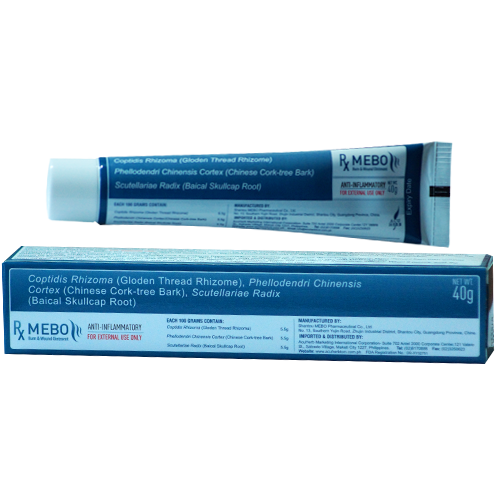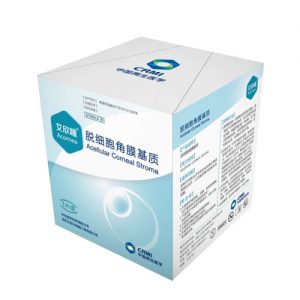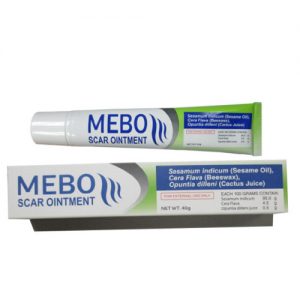Description
MEBO Burn & Wound Ointment was originally developed for the local and systemic treatment of burns. It has been found that the ointment, when applied topically to the burn wounds, liquefies and removes necrotic tissues, meanwhile protects and promotes the regeneration of residual viable skin tissues. During the entire treatment, wounds are kept in a physiological moist environment where all lives rely on for survival, in contrast to the conventional surgical burn therapy that requires the wound be kept in a dry environment.
Topical ointment made from natural ingredients including sesame oil, beeswax, and other edible herbs, which provide β-sitosterol, 18 natural amino acids, 4 essential fatty acids, vitamin E, and polysaccharides.
- Each tubes contains 40g.
- Ointment is yellow with a sesame scent.
Indications
- Burn wounds
- first degree
- superficial second-degree
- deep second-degree superficial type
- deep second-degree deep type
- superficial third-degree
- deep third-degree burn wounds
- burn wounds on bone
- electronic burns
- severe chemical burns
- Wound ulcer
- Diabetic ulcers
- Pressure ulcers( Bedsore)
- Traumatic wounds
- Soft tissue necrosis
- Surgical wounds
- donor site wounds
- cosmetic surgical wounds
- ostomy wounds
- wounds of circumcision
- obstetrical wounds
- Amputated Limbs
- Others
- Newborn diaper dermatitis
- Herpes zoster
- Common warts
- Corneal burn
- Traumatic keratitis
Product Advantages:
- Maintains wound in a physiological moist environment
- Promotes wound healing by activating and sustaining intrinsic regenerative potential of the body and cultivating stem cells of the body in situ and in vivo.
- Improves wound microcirculation in the zone of stasis
- Protects wounds from potential infection
- Minimizes pain and the use of analgesics
- Restores physiological structure and function of the body
- Promotes quality of healing by reducing scarring
Storage:
- Room temperature not exceeding 30°C
- Seal tube tightly after each use
Toxicity and Side effects:
MEBO is a pure herbal edible origin. No side effects to the product have been reported so far except for the allergic reaction to sesame oil.
Precautions:
MEBO Burn Ointment may change its physical appearance during storage, especially during hot seasons. But it does not lose its therapeutic efficacy. When it occurs, soak the screwed-tube in boiling water for several minutes and then stand to cool, its dosage form will return to normal.
MEBO Burn & Wound Ointment Home use Quick Guide
For family use, when flame burn, hot oil, hot water scald or skin abrasion occurs, MEBO should be smeared onto the wound immediately, and then pain alleviation, damage decreasing and infection prevention will be achieved.
The earlier the medicine application, the better is the effect.
Because after burn or scald, the remnant heat accumulated on the wound will cause progressive damage to the skin.
MEBO applied can remove the remnant heat in time and prevent the progressive damage.
Treatment condition: a clean or sterile (which is not absolutely necessary) environment is required. Temperature around the wound surface should be kept at 34–38°C.
Early wound care: any feculence and dirt should be cleared away. Do not use any method or topical drug that may cause further injury to the wound or promote tissue hydrolysis.
First Aid for burns injury MEBO Burn and Wound Ointment application
Immediately apply MEBO Burn and Wound Ointment on the wound to relieve pain, stop bleeding, alleviate injuries and prevent infection in cases of scalds and burns by hot oil, boiling water, or friction burns. The sooner, the better.
General Application of MEBO Burn and Wound Ointment
- For minor cuts, burns, scalds, scrape and wounds
- Directly smear MEBO ointment onto the wounds with a thickness of 1 mm
*At the beginning, no debridement is required except for chemical burns or dirty wounds. - Renew MEBO Burn and Wound Ointment every 3–4 h, before which wiping off the residual ointment and liquefaction products with gauze or tissue paper (gentle and careful renewal is demanded to avoid pains and bleeding).
*For wounds with blisters, be sure to preserve the blister skin, directly apply MEBO ointment until the blister skin is removed 5 days later.
- For degree burns* link to the treatment application
- First Degree Burns
- Treatment for Superficial Second Degree Burns
- Treatment for Deep Second Degree Superficial (DIIS) Burns
- Treatment for Deep Second Degree Deep (DIID) Burns
- Treatment for Third Degree Burns
- Chronic wounds link to the treatment application
- Treatment application for Bedsore/Pressure ulcer
- Treatment application Diabetic foot ulcer
- Others – The treatment application depends on the diagnosis of a medical doctor to the patient
- Chemical burns
- Traumatic wounds
- Corneal burns
- Traumatic keratitis
- Post-operative sites
Treatments
Treatment for First Degree Burns
1. First degree burn, skin redness, slight swelling and pain.

2. Apply MEBO immediately postburn. With the absorption of MEBO, pain is relieved and edema fades away gradually. Continue applying MEBO.

3. Two to three days later, burned skin would heal. Continue applying MEBO as a protective ointment for about one week so as to fully restore normal skin functions.

Treatment for Superficial Second Degree Burns
1. Apply MEBO with thickness less than 1 mm.
Release water in blisters at low position and do not remove the blister skin.

2. Three to four days later, remove the blister skin and apply MEBO immediately.
Smear MEBO along the direction of fine hair gently to relieve stimulations.

3. Four to six hours after applying MEBO, a layer of white liquefied exudates was formed. It is a normal phenomenon of excreting necrotic skin tissues.

4. Clean the liquefied products with no injury. Redress MEBO without pains, bleeding or damage to live tissues on wounds.

5. Alternatively, use disinfected gauze to absorb liquefied products for 30 seconds or 1 minute.

6. Disclose gauze tangential direction

7. Clean the liquefied products completely.

8. Smear MEBO evenly on wounds. The thickness is less than 1 mm.

9. Seven days later, wounds heal. Apply MEBO as a protective ointment for 7-10 days so as to restore normal skin function.

Before & After Application
Treatment for Deep Second Degree Superficial (DIIS) Burns
1. On 1st day of postburn wounds is superficial II degree burns mixed with deep II degree burns. There are blisters in different sizes.
Release water in blister and retain blister skin.

2. Apply MEBO directly and protect wounds.

3. On the 3rd day postburn, apply MEBO on wounds. Edema fades away and a layer of soft membrane forms on

4. On 4th day postburn, superficial II degree burns gradually heal.
Necrotic tissues are liquefied on deep II degree superficial type wounds.
Redress MEBO every 4 hours (6-8 hours at night) and remove the soft membrane.

5. On 8th day postburn, deep II degree superficial wounds continue being liquefied.
Clean the liquefied products and necrotic skin complying with the principle of “Three No” before redressing MEBO.

6. On 12th day postburn, necrotic tissues are liquefied and discharged.
Under protection of fabric isolating membrane, wounds are repaired to heal.

7. On 15th day post burn, most wounds are repaired to heal.

8. On 25th day postburn, all wounds heal.
Continue using MEBO as protective ointment for 10-15 days until skin functions are restored.

Before & After Application
Treatment for Deep Second Degree Deep (DIID) Burns
1. After simple debridement, apply MEBO immediately to protect wounds.

2.On 5th day postburn, remove necrotic skin. Necrotic tissues on wounds are liquefied and discharged.
3. A layer of fibrous isolating membrane forms on wounds under the action of MEBO.

4. Apply MEBO complying with the principle of “Three No” (Don’t cause pain, don’t cause bleeding and Don’t cause any further damage in the normal skin tissue) and protect the membrane to promote repairing of wounds.

5. On 30th day postburn, burn wounds regenerate and repair.

6. Continue applying MEBO for 10-15 days to protect healed skin.

Before & After Application
Treatment for Third Degree Burns
1. III degree burn with area of 85%TBSA.The pathological section at right side shows full-thickness skin necrosis.

2. Apply cultivating and tension relieving method on III degree wounds on chest. Apply MEBT/MEBO to treat.
3. Clean liquefied necrotic tissues in time and treat wounds complying with the principle of treating deep II degree burns.

4. On 20th day postburn, burned necrotic tissues are liquefied and discharged. A layer of membrane forms on wounds. The pathological section shows that wounds were repaired by regenerative skin tissues.

5. Under the protection of MEBO and membrane, regenerative skin tissues form dense skin islands.

6. Pathological section: stem cells regenerate and repair skin in situ.

7. ‘Skin islands’ gradually extend to normal skin tissues.

8. On 49th day postburn, the pathological section of healed skin shows structure of normal skin.

9 . On 7 2nd day postburn, whole layers of skin regenerate, repair and heal.

Before & After Application
Bedsore (Pressure ulcers)
Areas of necrosis and ulceration where tissues are compressed between bony prominence and hard surfaces; they result from pressure alone or pressure in combination with friction, shearing forces, or both. A number of contributing or confounding factors are also associated with pressure ulcers.
Before & After Application
Treatment method:
Smear 2-3 mm thickness of MEBO Burn and Wound Ointment evenly on the wound and then put a bandage dressing. Change dressing twice a day.
Three days later, the necrotic tissues and the fibrous lamina around the wound are moisten by MEBO and turn soft and loose.
Then surgical knife or scissors are used to remove the necrotic tissues to keep the wound relatively fresh. MEBO should be used 2 times a day.
Before each redressing, the necrotic tissues and also the secretion should be cleared completely. 10 to 15 days later, the wounds turn better obviously. Dressing is continued once a day.
For those not suitable for exposed therapy, the wound can be bandaged until the wound is healed.
Diabetic foot ulcer
A major complication of diabetes mellitus, and probably the major component of the diabetic foot. Diabetic foot ulcers are caused by neuropathic (nerve) and vascular (blood vessel) complications of the disease.
Before & After Application
Treatment method:
Smear 2-3 mm thickness of MEBO Burn and Wound Ointment evenly on the wound and then put a bandage dressing. Change dressing twice a day.
Three days later, the necrotic tissues and the fibrous lamina around the wound are moisten by MEBO and turn soft and loose.
Then surgical knife or scissors are used to remove the necrotic tissues to keep the wound relatively fresh. MEBO should be used 2 times a day.
Before each redressing, the necrotic tissues and also the secretion should be cleared completely. 10 to 15 days later, the wounds turn better obviously. Dressing is continued once a day.
For those not suitable for exposed therapy, the wound can be bandaged until the wound is healed.
Remember that: for diabetic ulcers, asking internist for examination and treatment is a necessity. Control blood sugar and harnzucker and pay attention to diet regulation. Or else the chronic ulcer will not heal.
Burn & Wound Treatment Application
Exposed therapy
- Directly smear 1mm thickness of MEBO Burn & Wound ointment on the wound.
- Yellowish exudates or milky liquefied layer will appear after 4-6 hours of MEBO Application. Use sterile gauze, tongue depressor, forceps, or scissor to remove these exudates and residual of MEBO.
- Re-apply 1 mm thickness of MEBO Burn & Wound Ointment on the wound..
- Change dressing every 4-6 hours until the wound is healed.
Semi-Exposed therapy
- Prepare “MEBO Gauze” by soaking 1 layer of dry sterile gauze with MEBO until gauze is saturated with MEBO ointment.
- Apply 1 layer of soaked MEBO gauze on the wound.
- When yellowish or milky exudates appear, remove MEBO gauze first and gently remove exudates and MEBO residual by using a sterile gauze, tongue depressor, forceps, or scissors.
- Change dressing every 8-12 hours until the wound is healed.
Bandage Therapy
- Prepare “MEBO Gauze” by soaking 2 layer of dry sterile gauze with MEBO until gauze is saturated with MEBO ointment.
- Directly smear 2-3 mm thickness of MEBO Burn & Wound Ointment and apply 2 layers of soaked MEBO gauze on the wound.
- Remove MEBO gauze first and gently remove exudates and MEBO residual by using a sterile gauze, tongue depressor, forceps, or scissors.
- Change dressing once or twice a day until the wound is healed.



















































Reviews
There are no reviews yet.